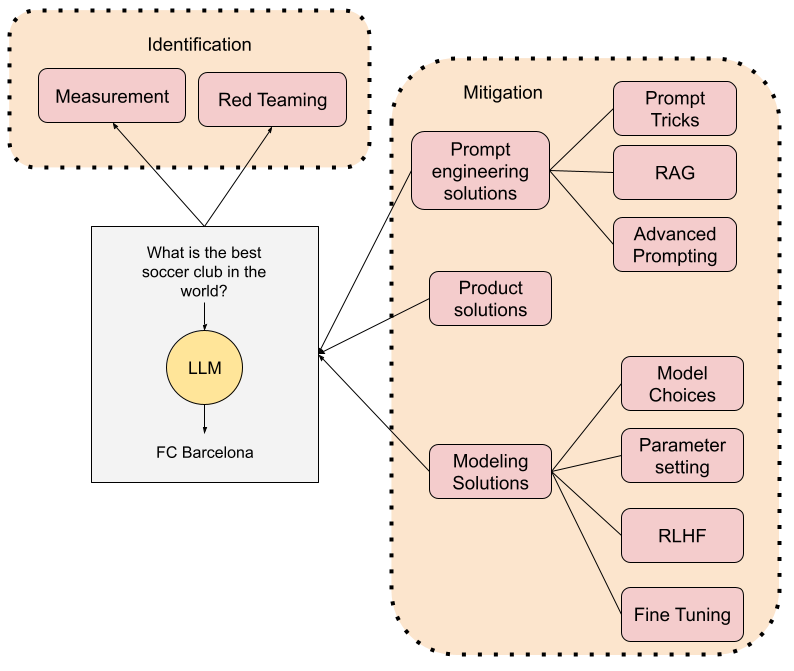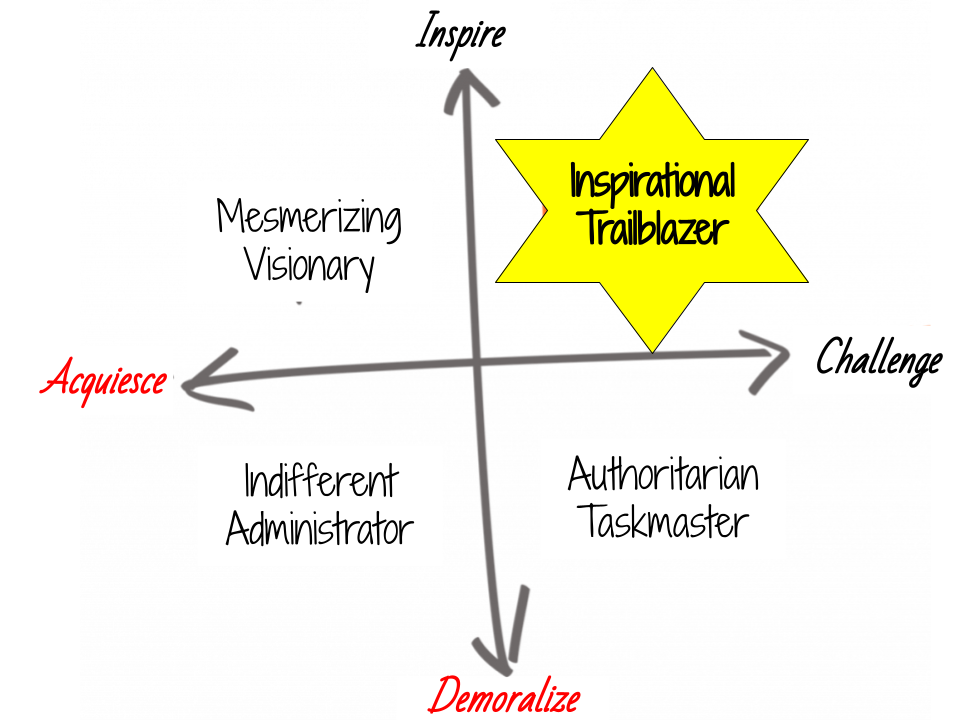If you have been following my journey for a while, you’re probably aware of my fascination with decision-making frameworks. The line between success and failure, whether in businesses or individual lives, often hinges on the quality of decisions made. In a previous blog post, I delved into decision-making within organizations. Today, I’m excited to share a personal decision-making framework that has been instrumental in navigating significant life choices, most notably in my recent career transition.
Imagine standing at a crossroads in your career, pondering your next move. That was me, not too long ago. The decision about where to take my professional path next was daunting, prompting me to refine and formalize a decision-making framework I had been using intuitively. Drawing inspiration from luminaries like Kahneman to Bezos, this framework evolved into a structured process, complemented by a practical spreadsheet tool. Upon sharing this toolkit with friends and colleagues, the feedback was unanimous: it was a game-changer. I’m confident it will serve you just as well.
Standing on the Shoulders of Decision-Making Giants: Kahneman’s Framework
Nobel laureate Daniel Kahneman, a towering figure in the study of human judgment and decision-making, has extensively explored the intricacies of our decision-making processes. His latest book, Noise, sheds light on the pitfalls of human judgment and our susceptibility to error. Contrary to what one might expect, Kahneman doesn’t advocate for a purely rational, data-driven approach to decision-making. Instead, he introduces the concept of “delayed intuition,” where intuition plays a role only after a thorough analysis of data and information. This nuanced approach resonates deeply with the framework I’ve developed. For a more digestible overview of Kahneman’s insights, I highly recommend this interview with Adam Grant, where the essence of “delayed intuition” is brilliantly unpacked.
In the next section, I’ll unveil the visual representation of this decision-making framework, which has not only guided me through pivotal career decisions but also equipped others with a powerful tool for navigating life’s crossroads.
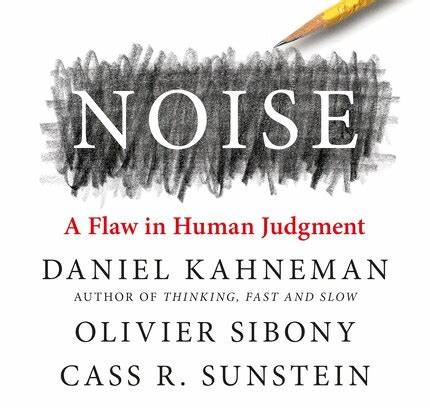
The Data-Informed Gut Decision-Making Framework
At the heart of my approach lies the Data-Informed Gut Decision-Making Framework, which is elegantly simple yet profoundly effective. It unfolds in two pivotal steps: (1) Data and information collection, followed by (2) An informed gut decision based on this groundwork.
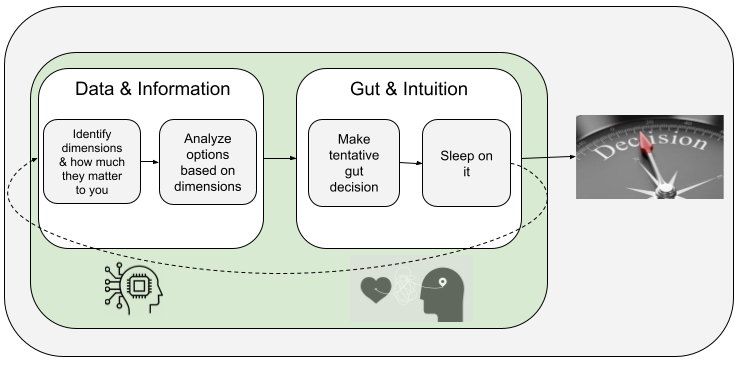
The notion of integrating ‘gut feeling’ with data may seem unconventional to some. Yet, it’s a method even industry titans swear by. Take, for instance, Jeff Bezos’ approach at Amazon. The company is renowned for its operational rigor, but what might be less known is Bezos’ “70% rule”. This principle advocates for decision-making once 70% of the requisite information is in hand. The rationale is threefold: achieving 100% data is a myth that only hampers decision quality, acting on 70% data accelerates decision-making, and embracing this partiality allows for swift corrective measures if needed. Aiming for complete data is a mirage that could lead to indecision and missed opportunities.
With this framework outlined, let’s delve into its components, beginning with the critical first step.
Step 1: Gathering Data and Information - The Decision-Making Spreadsheet
The journey to an informed decision starts with data and information gathering. It’s crucial to approach this phase with structure and objectivity. The process bifurcates into first identifying the decision dimensions that matter to you and assigning them appropriate weights, and later evaluating how each of your options provide the dimensions you care about. These dimensions are reflections of your long-term aspirations, though they naturally evolve over time and vary according to the decision context.
For instance, when weighing job opportunities, ‘Salary Increase’ might take precedence. Conversely, in lifestyle decisions, other factors might come to the fore. The task is to enumerate these dimensions and assign them weights on a scale from +5 to -5, acknowledging that some aspects might inherently carry negative connotations, such as ‘Work Travel.’
Previously, I employed paper cards for this exercise, but have since transitioned to a digital format for efficiency and clarity. You’re invited to explore an exemplar of this process through the decision-making spreadsheet I’ve shared.
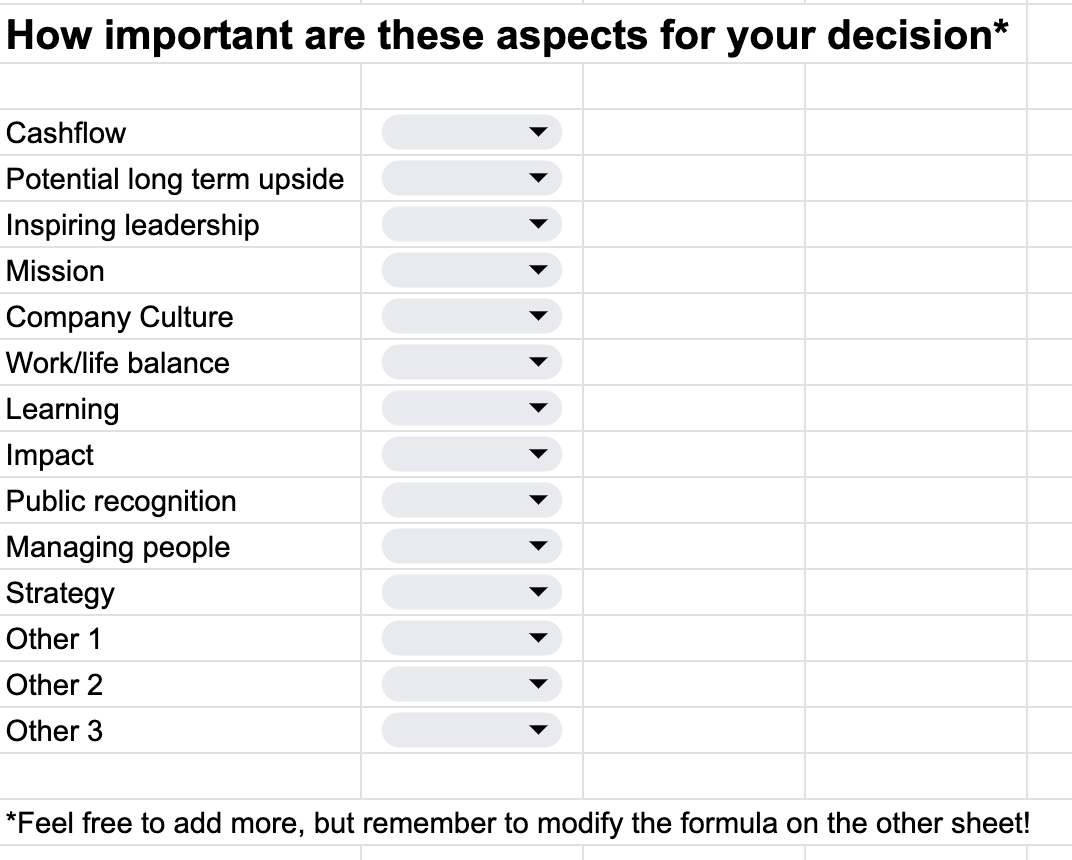
Upon defining the dimensions and their weights, the next step is to assess how well each option scores against these criteria. This can be systematically done using the spreadsheet’s second tab, leading to a calculated weighted sum that signifies each option’s total value. While this method assumes independence between dimensions—a simplification aficionados might debate—it serves as a robust starting point for most decision-making scenarios.
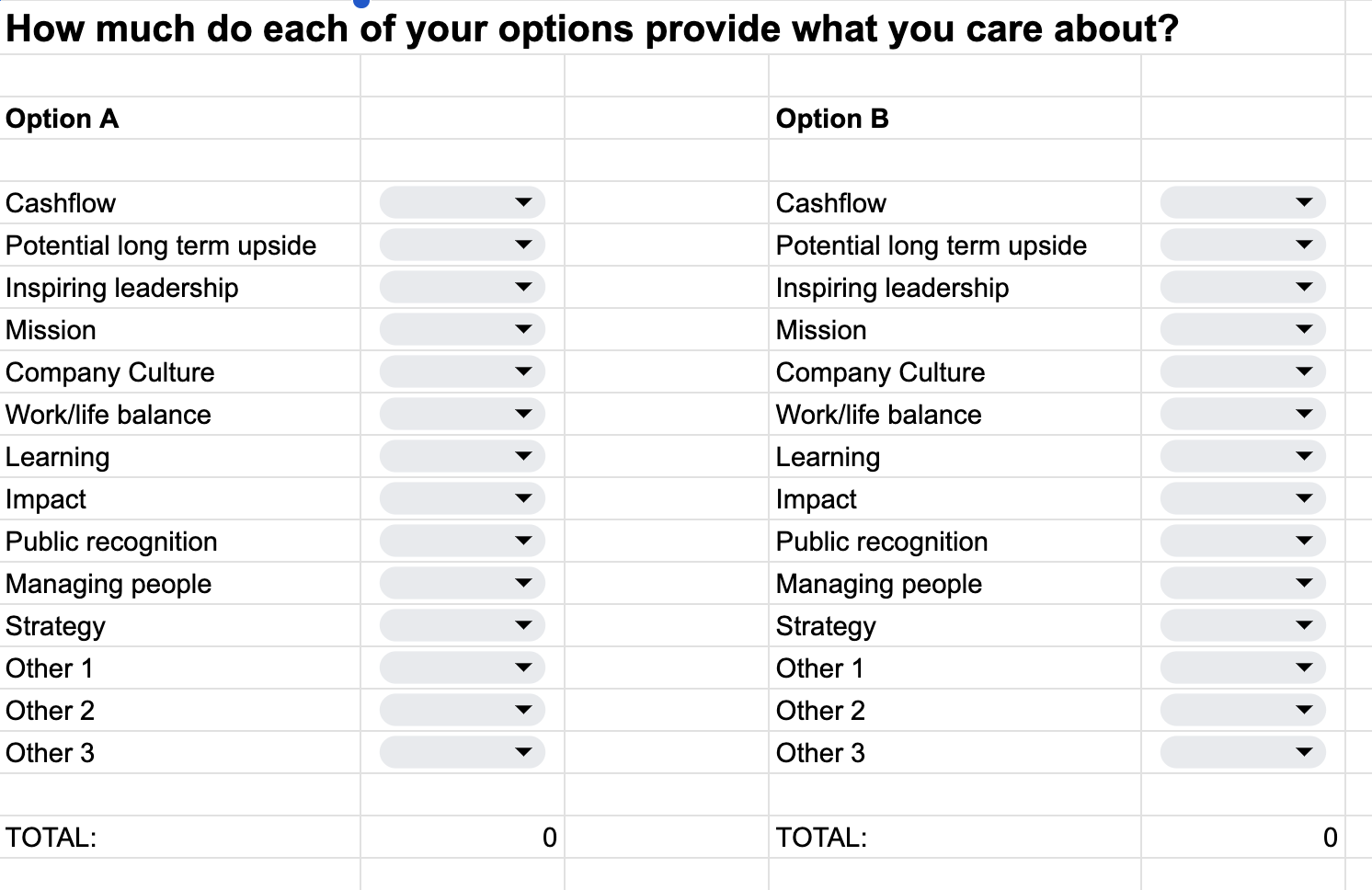
With this comprehensive evaluation in hand, take a moment to reflect on the findings. Let the insights marinate before proceeding to the crucial second step, where intuition and data converge to guide your decision.
Step 2: Engaging Your Intuition
With a solid foundation of data and analysis from Step 1, it’s time to shift gears and tune into your intuition. This phase is about marrying the quantitative with the qualitative, allowing your inner voice to have a say in the decision-making process. Reflect on which option resonates with you on a deeper level, beyond the numbers and facts.
It’s crucial here to guard against the paralysis of ‘what-ifs.’ Encourage yourself to lean towards a decision, even if tentatively. Emulate living with that choice for a few hours or even a day. The ‘sleep on it’ test can be particularly revealing, offering insights into your subconscious inclinations. If you wake up feeling positive about your provisional choice, it could be a green light. But remember, hesitancy or doubt at this stage is not uncommon and leads us to the crucial next step: iteration.
[AI Digression] Before we proceed, let’s take a moment to reflect on the role of AI in decision-making. As an AI enthusiast, I recognize its transformative potential in organizing and analyzing data (Step 1). Yet, AI’s utility has its limits. The realm of intuition, gut feelings, and the nuanced understanding of human emotions remain uniquely human. AI lacks the ‘gut’ to make nuanced decisions, the intuition to ‘feel’ the right choice, and the accountability that comes with decision-making. This underscores the enduring value of human judgment, especially in a landscape increasingly navigated with AI assistance.
Step 3: The Iterative Process
Decisions of significant impact rarely come easy and often require revisiting and refining. This iterative process is not a sign of indecision but a hallmark of thoroughness. Should your intuition nudge you towards an option that doesn’t top the ‘rational value’ charts, it might be time to reassess your initial dimensions and weights. Are they truly reflective of your priorities and values?
Conversely, if the most logical choice leaves you feeling uneasy, it’s worth exploring that discomfort. It could be an indicator that not all variables have been accounted for or that their significance needs re-evaluation.
Iteration is particularly pertinent when information is incomplete or evolving, as is often the case in dynamic scenarios like career transitions. Engaging in further conversations, seeking additional insights, and continuously revising your data can illuminate new perspectives, ultimately guiding you towards a decision that aligns with both your rational assessment and intuitive sense.
Decision-Making Time
With thorough iteration and a deep dive into your options, the moment to decide arrives. Echoing the wisdom of not seeking absolute certainty, remember: perfection in data is unattainable. All of the important decisions I have made in my life were guided by this very framework, embodying the principle of acting on 70% information. Dwelling on marginal gains in data can be an exhaustive endeavor with diminishing returns. No matter how important your decision is, going from 70 to 75% of information might take you weeks or months. Embrace the calculated risk and make your decision with confidence.
After Your Decision: Commitment and Course Correction
The decision made, the next critical phase is wholehearted commitment. Dive in with dedication to bring your choice to fruition. Yet, maintain the humility to recognize the potential for missteps. Regularly revisit your decision framework and the assumptions that underpinned your choice. Life is dynamic, and new information may necessitate recalibration. Commitment should not equate to rigidity; adaptability in the face of new evidence is a strength, not a weakness. Avoid the trap of sunk cost fallacy, where past investments dictate continued allegiance to a faltering path.
Conclusion: Embracing the Future of Decision-Making
In our rapidly evolving digital era, characterized by the ascent of artificial intelligence, the art of decision-making gains unparalleled significance. As AI augments our ability to process information, the distinctly human capacity to make informed, intuitive decisions becomes our most critical asset. This framework, a synthesis of data-driven analysis and intuitive judgment, is designed to enhance this capacity.
Through this journey, I’ve shared a methodology that transcends the mere mechanics of decision-making, aiming to empower you with a tool for not just success, but also fulfillment. The Data-Informed Gut Decision-Making Framework is more than a process; it’s a pathway to navigating life’s myriad choices with confidence and wisdom.
As we stand on the threshold of the Age of AI, let us harness these advancements not as replacements but as companions in our decision-making endeavors. I invite you to embark on this journey, leveraging the spreadsheet and framework I’ve shared, to cultivate a life rich in purposeful choices. Here’s to making decisions that not only propel us towards our goals but also enrich our human experience. Are you ready to embrace the power of data-informed gut decisions?
